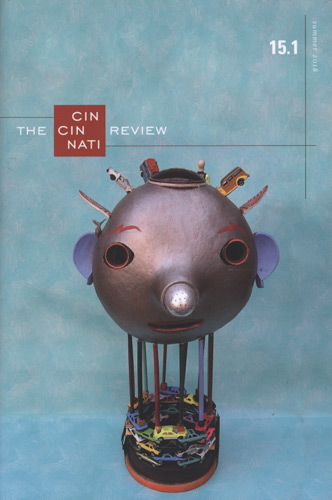The Cincinnati Review – Summer 2018
Not long ago, the food writer Jeffrey Steingarten asked an intern where she was from. Amused by her answer, he replied with his trademark sneer, “I didn’t think one could live in Cincinnati.” The Queen City has taken its lumps over the years, but despite chocolate in chili and the often-frustrating Bengals, Cincinnati is emerging as one of America’s great, underrated cities. The culinary scene is exploding, vibrant murals bring life to street corners, the city’s sweetheart soccer team has just snagged an expansion slot from Major League Soccer, and community revitalization efforts shift the focus back from gentrified hotspots to the neighborhoods that need it most. Somewhere in this swirl of cultural growth sits The Cincinnati Review, a product of the University of Cincinnati’s Department of English and Comparative Literature.
Not long ago, the food writer Jeffrey Steingarten asked an intern where she was from. Amused by her answer, he replied with his trademark sneer, “I didn’t think one could live in Cincinnati.” The Queen City has taken its lumps over the years, but despite chocolate in chili and the often-frustrating Bengals, Cincinnati is emerging as one of America’s great, underrated cities. The culinary scene is exploding, vibrant murals bring life to street corners, the city’s sweetheart soccer team has just snagged an expansion slot from Major League Soccer, and community revitalization efforts shift the focus back from gentrified hotspots to the neighborhoods that need it most. Somewhere in this swirl of cultural growth sits The Cincinnati Review, a product of the University of Cincinnati’s Department of English and Comparative Literature.
The Summer 2018 issue, like the city itself, is daring and full of life, not without complication or cause, in some areas, for criticism. The place where it absolutely shines, though, is poetry. This issue’s stanzas crackle with electric wit, playfulness, and beauty, approaching the known and unknown with unfamiliar or lyric phrasings that untangle our world or else ball it up with a devious grin. In “Depth Perception,” Jennifer Atkinson writes:
In larval dark, an early instar of music, blue
Burns cold in uncreated space, bloomingInaudible, un-auroral, into the almost visible spectrum
The first low indigo note, under the silence, a thrum.
Later, in “Dead Battery Contestant,” Emily Koehn abstracts to the extreme an interaction as simple as the poem’s title, imbuing it with high tension, splitting it into still frames, like photographic evidence of a crime in progress, or one yet to be perpetrated, or no crime at all. She writes, “What I want then is truth or at least a faint fiction writing faith all over a / body.”
In an excerpt from “When Rap Spoke Straight to God,” Erica Dawson is straightforward, documenting harassment, excoriating herself, remembering, fearing, stating bluntly. She writes:
One time, Dad tried
to race a smoke on the side of the house he thought
we couldn’t see, maybe hoping the wind
would wash off the smell of a cop’s night shift, maybe
refill the sockets of his knocked-out teeth.That’s when I realized that breath was white.
Although the prose, overall, takes a backseat to the poetry in the issue, “Different Animals” by Jameelah Lang stands out. The story follows Virginia, a nursing assistant whose husband left her after they couldn’t have children. Virginia’s normal routine, which involves sidestepping religious fundamentalist protestors and providing weekly checkups to a handsome hypochondriac she’s dubbed “the nose man,” is thrown into disarray when the young daughter of a minister comes in seeking an abortion. Lang’s story tests each pressure point with precision, building up to a tense yet fulfilling finish. Lang writes:
Outside the glass door, the crowd moved and motioned with more liveliness than usual, their arms waving and their mouths popping open and shut with words that Virginia could not hear, a single undulating mass, some unfamiliar beast with dozens of eyes and legs.
By the story’s close, the reader is fully attentive to the fact that even unhappy worlds can come crashing down.
New to The Cincinnati Review is the Play-in-Progress section. This issue features work by MJ Kaufman. Drama Editor Brant Russell introduces the new series with an argument for its existence, stating that a playwright’s early drafts, prior to the collaborations that transform the work into a living, breathing thing, have much in common with the work of a novelist or an essayist. It is easy to accept this premise; both categories of writer are putting words on the page, creating characters and narratives for an audience. However, these forms should not be considered equal. The novelist’s work, the essayist’s work, is finished, the playwright’s work is a draft, a curiosity that derives its energy from the cast and crew that make it whole. Kaufman’s play-in-progress has an intriguing plot, but its cacophony of voices, its very nature, isn’t suited to the page, and especially not the fifty-four pages it occupies in the current issue. As Russell himself says at the start of his essay, “Drama is the opposite of literature.” The series feels misplaced, a stranger in its new home.
Like the city it’s named for, The Cincinnati Review is an evolving creature made up of diverse voices and experiences. It is this difference that enables growth. To its readers: whether you open this issue in Washington Park, on the serpentine steps, or in another city or state altogether, you’re sharing an experience, a collection of art created by people who write in order to share their humor, their sorrow, their point of view. Take that experience in and treasure it.
[www.cincinnatireview.com]





